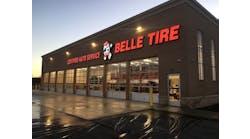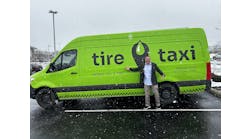Modern Tire Dealer Celebrates 75 Years of Excellence: 75 years of service
By 1919, the country had already witnessed 10 years of motor travel in Henry’s venerable Model T and emerging competitive vehicles of the time.
Ford’s wooden-framed chug-buggy, only capable of a modest 35 miles-per-hour on today’s modern roads, sputtered its way along the dirt, gravel and brick roadways of the time, often axle-deep in mud during foul weather.
It was a far cry from the sleek, aerodynamically efficient, passenger-friendly cars we know 75 years later.
As automotive technology has progressed service support has likewise seen quantum leaps in the equipment and tools required to sustain automotive life.
Seventy-five years ago, the fledgling automotive repair shop managed to operate with a short list of items that might have included a source of compressed air, a forged steel breaker-bar, a few tire irons, a handful of wrenches and an acetylene torch.
The high-tech shops may have added a few ail drills, air hammers and impact wrenches.
In the beginning, vehicle undercarriage work was performed by jacking up the car on a stand, or accessing it from an open service pit.
Tire repair alone was then a mainstay of the independent shop.
An article on a survey of dealers in our 1920 magazine reported that the typical shop could squeak by with a $750 expenditure in tire repair materials.
Add the torch, a few floor jacks, a bench vise and a variety of hand tools, and you’re looking at maybe $1,200 to $2,000 to equip a complete shop of that era.
By contrast, a shop today may be outfitted with one or more vehicle lifts at a cost of $3,000 to $8,000 each, an alignment rack and system at $35,000 or so, a dynamic wheel balancer at $4,000, a pneumatic changer at $3,000, a brake pressure bleeder at $200, one or more air compressors at $1,500 each, an air conditioning station at $3,200, a combination brake lathe at $5,000, a four-gas BAR 90 exhaust analyser at $5,000 or so for diagnostic use, or possibly upwards of $40,000 tor a state-approved emissions program, and a decent assortment of engine diagnostic tools such as a multimeter and enough computer scan tools to handle most vehicles for a price tag of about $6,000.
Add a few hydraulic floor jacks, a selection of specialty tools such as pullers, spring compressors, etc., a rack and pinion bench vice, a hydraulic press and an assortment of air and manual hand tools, and today’s shop is facing a tool and equipment bill of $85,000 to $140,000 or more!
Also, consider the investment cost of technicians training for alignment, suspension work, engine diagnostics, climate control and ABS. Interestingly, the cost of a few items have actually decreased over the years. The behemoth rolling engine diagnostic analysers of the 1980s, for example, commonly in the $30,000 price range, have given way to a handful of scan tools, breakout boxes and multimeters, at a fraction of the “big scope” cost.



